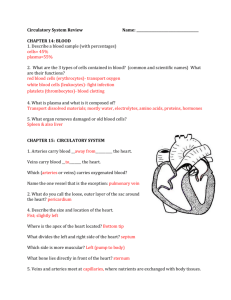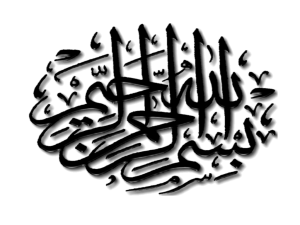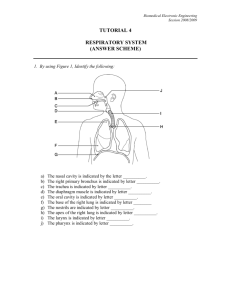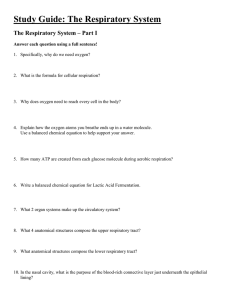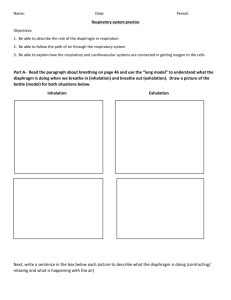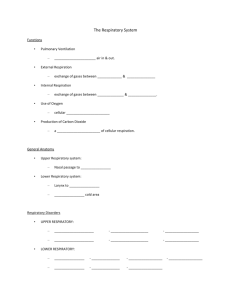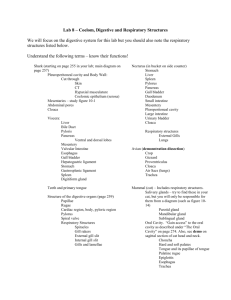The Respiratory System – Chapter 8 – New Textbook
advertisement
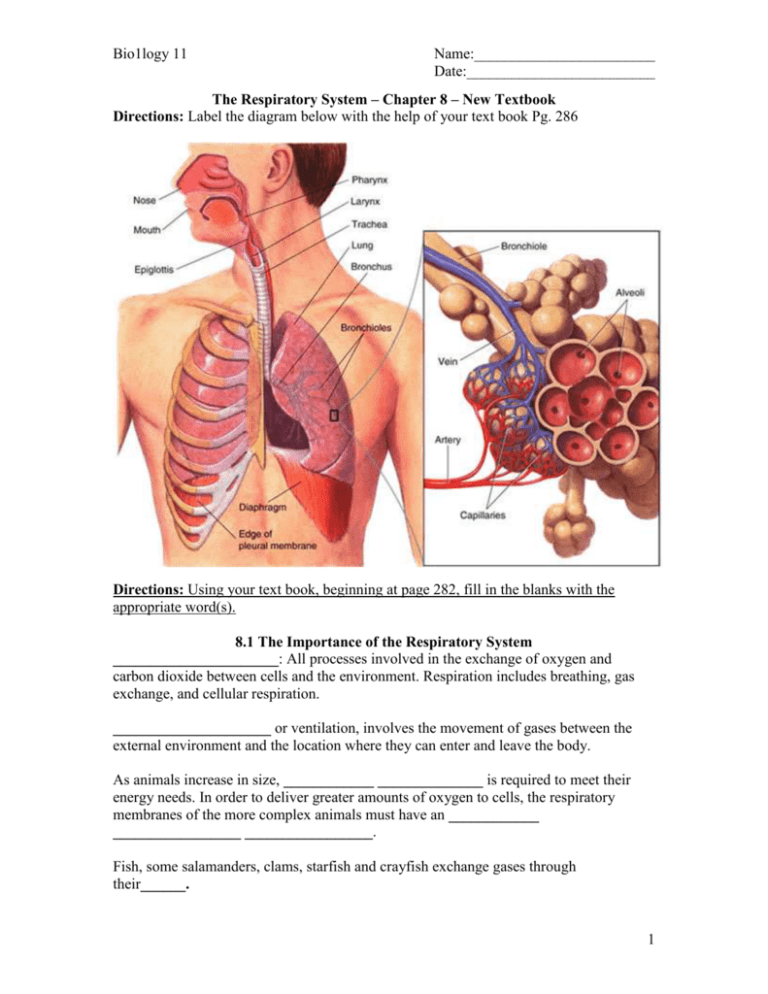
Bio1logy 11 Name:________________________ Date:_________________________ The Respiratory System – Chapter 8 – New Textbook Directions: Label the diagram below with the help of your text book Pg. 286 Directions: Using your text book, beginning at page 282, fill in the blanks with the appropriate word(s). 8.1 The Importance of the Respiratory System ______________________: All processes involved in the exchange of oxygen and carbon dioxide between cells and the environment. Respiration includes breathing, gas exchange, and cellular respiration. _____________________ or ventilation, involves the movement of gases between the external environment and the location where they can enter and leave the body. As animals increase in size, ____________ ______________ is required to meet their energy needs. In order to deliver greater amounts of oxygen to cells, the respiratory membranes of the more complex animals must have an ____________ _________________ _________________. Fish, some salamanders, clams, starfish and crayfish exchange gases through their______. 1 Bio1logy 11 Name:________________________ Date:_________________________ Fish also use a _________________________- the water moves over the gills in one direction while the blood contained within the capillaries inside the gill, moves in the opposite direction. Insects do not have the problem of losing too much water by evaporation through their respiratory membrane because it is located ________________________. Although frogs, like earthworms, can absorb oxygen through their ______, the lungs provide substantially greater _________________________. 8.2 Mammals In mammals, air enters the respiratory system either through the two ________________ or the ____________. Foreign particles are prevented from entering the nasal cavities by ________ ________ lining the passageways that act as a filtering system. The nasal cavities ____________________________ incoming air and contain mucus which traps particles and keeps the cells lining the cavities moist. The nasal cavities open into an airfilled channel in the mouth called the __________. Two openings branch from the pharynx, the ___________, or the windpipe, and the esophagus, which carries food to the stomach. The wall of the trachea is supported by ___________ _______, which keep the trachea open. Air from the pharynx enters the ________, or _________ ______, located at the upper end of the trachea. Inhaled air moves from the trachea into two __________, which like the trachea, contain cartilage rings. The bronchi carry air into the _____ and ______ __________, where they branch into many smaller airways called ______________________. Air moves from the bronchioles into tiny sacs called ___________. Measuring between 0.1 um – 0.2 um in diameter, each alveolus is surrounded by capillaries. Oxygen and carbon dioxide both move from areas of higher concentration, to areas of lower concentration. Therefore, oxygen moves from the air within the _______ to the _____________ while carbon dioxide moves from the __________, into the air inside the ________. 2 Bio1logy 11 Name:________________________ Date:_________________________ The _________________, a domeshaped sheet of muscle that separates the chest cavity from the abdominal cavity, regulates the pressure in the chest cavity. During inspiration, the diaphragm ________________, or shortens, pulling downward. The diaphragm is assisted through the action of the ____________________ muscles, which cause the ribs to move 8.3 Summary Gas Exchange and Transport Pg. 293 Diffusion of gas occurs from an area of high pressure to an area of _____ _____________. Homeostatic mechanisms help maintain gas levels. Chemical receptors detect a change in gas levels and send a message, via _________ _________, to increase or decrease breathing movements. ____________________: an inflammation f the bronchial tubes. _____________ _________: a respiratory disorder characterized by a reversible narrowing of the bronchial passage. ___________________: A respiratory disorder characterized by an over-inflation of the alveoli. 3 Bio1logy 11 Name:________________________ Date:_________________________ The Respiratory system Instructions: write the appropriate name for each structure in the table below next to its number. Example: 1. Nasal Cavity 1. 4. 7. 10. 13. 2. 5. 8. 11. 3. 6. 9. 12. 4 Bio1logy 11 Name:________________________ Date:_________________________ 5
